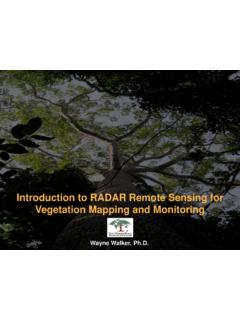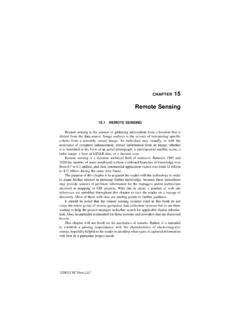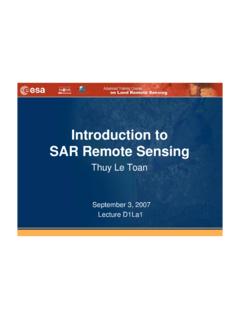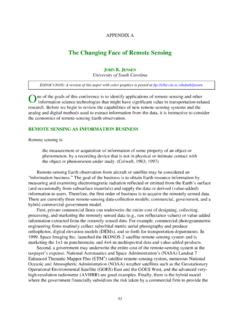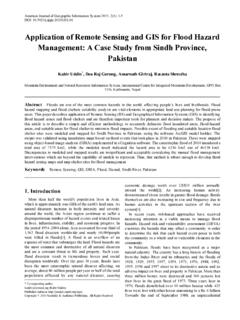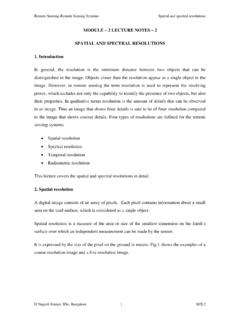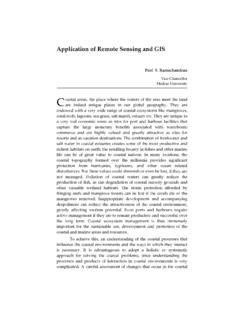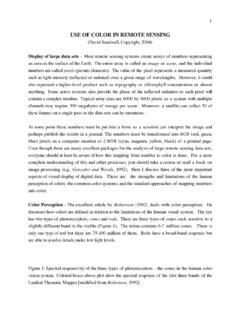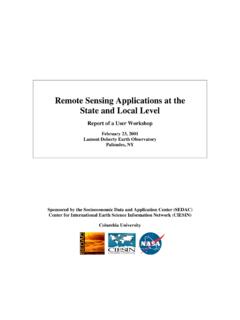Transcription of REMOTE SENSING AS ART - University of California, …
1 REMOTE SENSING AS ART USING SILK PAINTING TO TEACH ABOUT LANDFORMS ASSOCIATED WITH COASTAL WATERWAYS Based on a similar presentation by Dr. Lydia Dambekalns University of Wyoming SCIENCE OLYMPIAD SUMMER INSTITUTE Madison, Wisconsin JULY 21, 2004 Presented by: Mark and Bonnie Van Hecke REMOTE SENSING National Event Supervisors East China, Michigan Art is bringing what is inside of you To the outside And science is bringing the outside world in And understanding it. Lydia Dambekalns Presentation Objectives: 1. Explore the relationship between the self and the Earth s environment. 2. Apply the manipulation of REMOTE SENSING images to visual artistic expression.
2 3. Enhance student observation and inferential skills. 4. Meet the visual challenges of using color, design, and style in visual artistic expression. 5. Recognize creative process connections between science and art. 6. Identification of landforms associated with coastlines. 7. Explain physical and cultural phenomena associated with the REMOTE SENSING of coastal landforms including the earth processes that created them. 8. Prepare students for competition in the 2005 Science Olympiad REMOTE SENSING event. Content Objectives: 1. Students will understand the nature of color including: a. The electromagnetic spectrum b. Reading and interpreting REMOTE SENSING images c. False-color imagery by computer 2.
3 Students will understand the nature of design including: a. Composition b. Emphasis and elimination c. Abstraction d. Applied principles and the elements of design Creation of Participant Batik Images Using REMOTE SENSING Imagery Identification of Coastal Landforms and Description of Participant Images Interdisciplinary Applications of the Activity Resources 1. REMOTE SENSING Tutorials 2. REMOTE SENSING Images 3. Coastal Landforms 4. Classroom Sets of Silk Painting Supplies Science and Art All Art is but an imitation of nature Seneca In the science of Astronomy, we look up to the heavens to learn about stars and planets- their movements, chemical compositions and the laws of physics that may explain their formation, all the while contemplating whether or not we are the only intelligent life in the Universe.
4 In the study of REMOTE SENSING imagery, we look beneath us to study the spatial relationships between humans and their physical environment. In both cases, there is an obvious gap between what we can measure and analyze and what we feel to be true. Art on the other hand provides us with what is often an aesthetically pleasurable representation of an individual s views of the world and the Universe. Art is a visual or literary expression of the thoughts and feelings about the world and the individual realities of the artist. Yet artistic expressions may appear to be surreal or overly fantastic without some semblance of knowledge of the laws that govern the Universe. An understanding of creative process connections between science and art greatly enhances our ability to understand and appreciate the world and Universe we live in.
5 Let s begin by comparing the problem-solving skills used by scientists and artists to express their realities. Scientific Method Visual Artistic Expression Question or Problem Statement to be investigated by the scientist Message or Concept to be expressed by the artist Hypothesis or explanation of scientific phenomena Elements of color and design that will best convey the expression Experimental Design Elements Subjects Characteristics of subjects Consideration of bias Use of experimental and control groups Level of abstraction Design Composition Elements Subjects or characters Color selection and value Perspective and emphasis of expression Layering Level of abstraction It would appear then that both scientists and artists use similar creative process skills to express the realities that
6 They investigate or create. The use of art is thus a novel, interdisciplinary and potentially enjoyable approach in teaching science to children of all ages. In this activity, you will learn how to use REMOTE SENSING imagery to teach students about coastal landforms in an elementary or secondary Earth Science class. You can also apply this activity to geography to identify land use patterns or even in literature classes to storyboard a setting. First, we ll focus on the science of color and its expression in nature and alteration by man. REMOTE SENSING and Color Our normal view of the world is a horizontal one. The light reflected from an image you are looking at travels over a distance until it is captured by your eyes.
7 Each of your eyes then sends a signal to your brain where it is recorded and interpreted. More often than not, what we see horizontally in our normal range of vision is limited to a very localized area with all kinds of obstructions such as trees, buildings, and topographic features. Looking at objects such as planets, stars, and galaxies present other difficulties because of their vast distances from the earth. REMOTE SENSING is the use of instruments such as cameras, radar, and satellite imagery to capture the spectral and spatial relationships of objects and materials observable REMOTE SENSING -usually from above them (vertically). REMOTE SENSING expands the capabilities of human sight by allowing us to see a multitude of physical and human features over a wide area of perhaps hundreds of square miles.
8 For a REMOTE SENSING system to operate, there must be a source of radiant energy. This radiant energy is emitted directly from an object, such as the thermal energy generated by a forest fire, or is sunlight that is reflected or scattered from objects. There must also be a propagating medium such as the atmosphere, which allows the electromagnetic energy to move through it, as well as a sensor or energy detector such as a camera, satellite, or radar device to capture the image. The drawing below illustrates how each of theses elements- the source, medium, and sensor interact in a REMOTE SENSING system. REMOTE SENSING Systems Source: Up Close from Afar Sensor systems can be grouped in two different ways: as active or passive, and as photographic or digital.
9 A passive sensor only receives signals and requires a separate source of energy such as sunlight. Examples of passive sensors include cameras, thermal scanners, and multispectral scanners. Photographic sensors record electromagnetic radiation on film as an image. Digital sensors transform electromagnetic radiation into an electrical signal that can be amplified, recorded, and converted into digital values. Active sensors such as radar on the other hand both transmit electromagnetic signals and receive reflected signals. Active sensors thus do not need a separate energy source, and are useful for creating REMOTE SENSING images at night, or in overcast conditions. In preparing students for competition in the REMOTE SENSING event, we will confine our use of REMOTE SENSING imagery to the analysis of physical, human, and ecological phenomena on the planet Earth.
10 Students will be trained to look at the Earth and its features from a spatial perspective. Students will also learn about the relationship of the electromagnetic spectrum and digital imagery to REMOTE SENSING imagery, and how this knowledge is used in better understanding the world we live in. A spatial perspective is concerned with the whereness of physical and human features. Thinking spatially means having the ability to describe and analyze the organization of people, places, and environments on the surface of the earth. Geographers refer to the physical features of the Earth s surface and the activities that take place on Earth s surface as phenomena.
